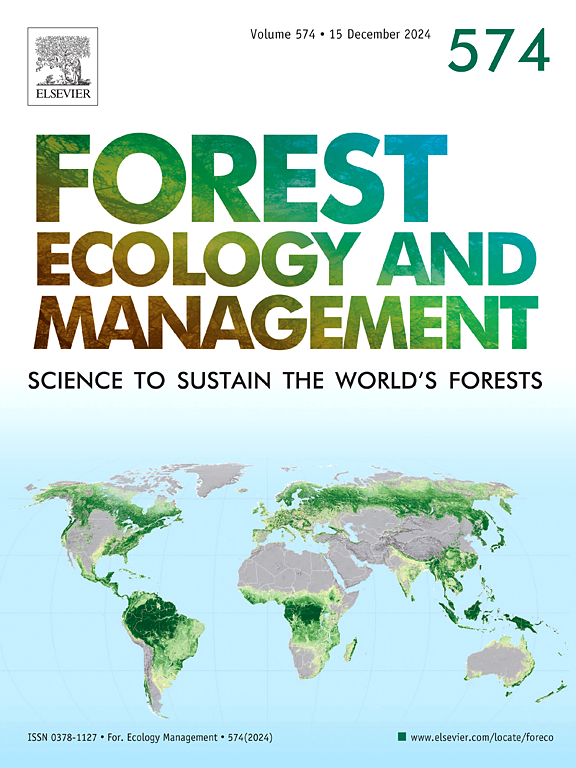Intraspecific responses to climate change in Cunninghamia lanceolata (Lamb.) Hook.: Local may not be the best
IF 3.7
2区 农林科学
Q1 FORESTRY
引用次数: 0
Abstract
The response of tree growth to ongoing climate change has significant implications for sustainable forest management. An analysis of 10-year diameter at breast height, height, individual stem volume, and volume per hectare was conducted for 43 populations of Chinese fir (Cunninghamia lanceolata (Lamb.) Hook.) grown in 32 common gardens across southern China. Population-specific performance under contemporary and future climate conditions was examined using response function and transfer projection. Findings indicated that mean temperature in the coldest month was the most influential variable in predicting population growth-related traits. Adaptation lags were more pronounced in populations at the climatic margins compared to core populations. On average, provenances from cooler climates benefited from long southward transfers (3.9–4.0 °C warmer), while warm-origin provenances responded favorably to shorter northward transfers (2.7–3.0 °C cooler). Calculated transfer limits were substantial, indicating populations could tolerate significant climatic shifts before experiencing a decline below 90 % of the local seed source's growth. The moderate climate model (SSP119) predicted minimal declines, whereas the extreme scenario (SSP585) projected significant growth reductions in southern populations. Other nonmarginal populations in near-optimal climates were also expected to be negatively affected, whereas most northern populations were projected to benefit from climate warming. These findings indicate that the response of Chinese fir to climate variation varies according to genetic differences between populations. These valuable insights are essential for the strategic selection of seed sources in reforestation initiatives.
杉木种内对气候变化的响应钩。本地的可能不是最好的
树木生长对持续气候变化的响应对可持续森林管理具有重要意义。对43个杉木(Cunninghamia lanceolata, Lamb)种群的10年胸径、高度、单株茎体积和每公顷体积进行了分析。),生长于中国南方32个普通花园。利用响应函数和转移预测研究了当前和未来气候条件下人口的具体表现。结果表明,最冷月份的平均温度是预测种群生长相关性状的最重要变量。与核心种群相比,气候边缘种群的适应滞后更为明显。平均而言,来自较冷气候的种源受益于较长的向南转移(升温3.9-4.0°C),而来自温暖气候的种源则有利于较短的向北转移(降温2.7-3.0°C)。计算出的转移限制是可观的,表明种群在经历低于90% %当地种子源生长的下降之前可以忍受显著的气候变化。中等气候模式(SSP119)预测南方人口的减少幅度很小,而极端情景(SSP585)预测南方人口的增长将显著减少。在接近最佳气候条件下的其他非边缘人口预计也会受到负面影响,而大多数北方人口预计将从气候变暖中受益。这些结果表明,杉木对气候变化的响应在种群间存在遗传差异。这些有价值的见解对重新造林活动中种子来源的战略选择至关重要。
本文章由计算机程序翻译,如有差异,请以英文原文为准。
求助全文
约1分钟内获得全文
求助全文
来源期刊

Forest Ecology and Management
农林科学-林学
CiteScore
7.50
自引率
10.80%
发文量
665
审稿时长
39 days
期刊介绍:
Forest Ecology and Management publishes scientific articles linking forest ecology with forest management, focusing on the application of biological, ecological and social knowledge to the management and conservation of plantations and natural forests. The scope of the journal includes all forest ecosystems of the world.
A peer-review process ensures the quality and international interest of the manuscripts accepted for publication. The journal encourages communication between scientists in disparate fields who share a common interest in ecology and forest management, bridging the gap between research workers and forest managers.
We encourage submission of papers that will have the strongest interest and value to the Journal''s international readership. Some key features of papers with strong interest include:
1. Clear connections between the ecology and management of forests;
2. Novel ideas or approaches to important challenges in forest ecology and management;
3. Studies that address a population of interest beyond the scale of single research sites, Three key points in the design of forest experiments, Forest Ecology and Management 255 (2008) 2022-2023);
4. Review Articles on timely, important topics. Authors are welcome to contact one of the editors to discuss the suitability of a potential review manuscript.
The Journal encourages proposals for special issues examining important areas of forest ecology and management. Potential guest editors should contact any of the Editors to begin discussions about topics, potential papers, and other details.
 求助内容:
求助内容: 应助结果提醒方式:
应助结果提醒方式:


